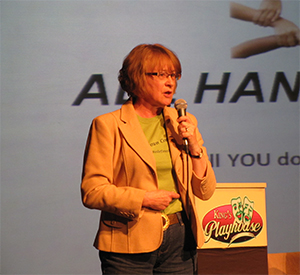Local newspapers keep communities alive

caption
Paul MacNeill says community newspapers support vibrant communities.Small town papers, facing big challenges, plan to survive
For perhaps the first time in his life, Paul MacNeill has taken a backseat.
In a small theatre in Georgetown, Prince Edward Island, MacNeill is sitting among 250 community leaders from across Atlantic Canada. Volunteers, activists and newspaper staff are discussing the issues plaguing their rural communities.
In January 2012 MacNeill found himself frustrated with local governments – again. Thinking enough was enough, he came up with the idea for the Georgetown Conference. Its aim is to harness the spirit of rural communities to help keep them thriving.
As the second-generation publisher of four community newspapers in P.E.I., MacNeill believes he’s in a unique position to see and understand public concerns. Like other rural journalists, he writes about the place he knows best – his community. He believes all community newspapers have a responsibility to start the conversation. The Georgetown Conference embodies that responsibility.
“Community newspapers are the logical champion of rural issues,” MacNeill says. “We write about whatever’s going on in our community. But there’s a bigger role our industry plays.”
Dennis Merrell, executive director of the Alberta Weekly Newspaper Association, attended the conference hoping to bring the idea back to the western provinces. Merrell shares the belief that community newspapers have the capacity to go beyond reporting. “I view the community newspapers as the canary in the coal mine,” he says. “If a community newspaper is surviving and doing well, it usually means that community still has some vibrancy.”
Like electricity, education and health care, community newspapers are a public service. Communities need their newspapers.
Ten years ago, 74 per cent of Canadians reported reading their community newspapers. Today, 73 per cent pick up those same newspapers for town hall updates, minor hockey scores and news about their neighbours.
Despite their unwavering readership, community papers face challenges. Corporatization by media giants and disinterest from major advertisers is resulting in the restructuring and closure of community newspapers across Canada. Like all other media, they are struggling.
Jock Lauterer wrote for community newspapers for most of his career. His experience inspired him to write Community Journalism: Relentlessly Local. Lauterer, who lives in Carrboro, N.C., travels around the world to research and discuss the need for community newspapers. Whether they serve a rural region of P.E.I., the outskirts of a town or a subculture within a city, community newspapers are quenching a thirst for news close to home.
“[They] reinforce the sense of community,” Lauterer says. “Everybody wants to belong. Everybody wants to feel like they’re of value, that they’ve somehow been authenticated, that they count, that they matter. Nobody wants to float through space with no gravity.”
People felt like they had a voice… like the town had a sense of place and identity.Jock Lauterer, journalist and author
Lauterer says community newspapers have three things in common: a readership of less than 50,000, an exclusive focus on stories with a local connection and offices accessible to their readers.
In his small town of Carrboro, N.C. (pop. 20,433) Lauterer saw the upstart of a community newspaper change the way residents existed. “We saw this exponential growth of civic engagement and involvement, and people felt like they had a voice,” he says. “They felt like the town had a sense of place and identity and a platform.”
The Carrboro Citizen opened in 2007, and folded five years later years because it couldn’t get enough support from advertisers. Lauterer says the impact of the loss on the community was obvious. Carrboro residents were left in the dust.
Focus shifts
The closure of community newspapers has been a topic of discussion over several years both in Canada and the United States. The purchasing of newspapers by media giants has caused the closure of several prominent community publications. Of the 1,019 community newspapers registered with Newspapers Canada, 605 are corporately-owned. Sun Media is largest owner in the country. According to the Globe and Mail, since 2012 Sun Media has cut 850 jobs and closed more than a dozen community papers. In June 2012, the corporation announced the closure of the Lindsay Post. The paper successfully served the people of the eastern Ontario community for more than 152 years.
For many affected papers, mergers and job cuts mean the loss of local publishers. When purchasing a paper, corporations often bring in their own executives – and the focus shifts from community needs to the needs of shareholders.
John Miller, former head of the Ryerson School of Journalism, says the emphasis on making a profit takes away from the emphasis on producing a quality paper. He says this was the case when Conrad Black purchased the Evening Guide in Port Hope, Ont. – Miller’s own community. He and a group of concerned citizens performed an audit on the Evening Guide after Black’s company Hollinger brought in a non-local publisher, and found more than 100 errors in one edition.
Miller says this has negative effects on newspapers and on communities. “The very fabric of the community is being undermined because people don’t have a reliable way of exchanging information and learning about important developments that might affect them,” he says.
Miller’s 1998 book Yesterday’s News was an examination of the state of daily newspapers in Canada. While researching his book, he spent time at an independent, family-run newspaper in Quebec. He believes corporate dailies can take lessons from independent community newspapers that have successfully served readers for decades. Those lessons include focusing on good local news.
Unfortunately for community newspapers, it isn’t as simple as providing good local news and pleasing the reader. All newspapers need to catch – and keep – the attention of national and local advertisers. These are businesses that need to make money, and they’re not just competing with each other – they’re competing with the Internet.
Kelly Levson is director of research at Newspapers Canada, which aims to create a strong industry voice for newspapers. Levson says major advertising companies are putting ad dollars into online campaigns instead of newspapers. Levson says it’s often challenging to convince national advertisers to invest in community newspaper,s because major ad firms don’t necessarily understand their relevance. Community newspaper associations across the country are working on putting small papers online to show national advertisers there is a demand for their products. Despite these efforts, online newspaper ad profits aren’t increasing fast enough to support these papers. A recent report in the Globe and Mail suggests the newspaper industry as a whole will suffer a 20 per cent advertising and circulation revenue loss by 2017.
But community papers have a secret weapon – local advertisers. Levson says dedication from local businesses could keep community newspapers afloat while they find a solution to the loss of national advertising. “That’s the key to keeping the community newspapers going,” she says. “That’s why the more successful ones are the ones that actually make a difference in the community; they’re the ones that are actually reporting on what’s going on in their community.”
When MacNeill’s father, Jim, opened the Eastern Graphic in 1963, he developed a connection to his community. He wanted to bring local news to the people of eastern P.E.I. By spending time in coffee shops and immersing himself in the culture of Montague, Jim quickly built a reputation as a man of the people. He needed them for stories and they needed him for news. Spending his own money to pursue stories no one else had was more of a priority than collecting money from advertisers.
MacNeill says his family’s intention has always been to put readers and the community first. “We have the ability as an independent company to make decisions in short order. And a lot of times our decisions are based, not necessarily on our financial bottom line, but on what’s best for the community.”

caption
editor Belle Hatfield says papers sustain communities.Jim MacNeill’s stark and often controversial editorials helped to determine the Graphic’s slogan, The Lively One. The communities it served could rely on the Eastern Graphic to report on the local strawberry festival on one page, and question politicians on the next. Taking on the subjects people preferred to avoid and holding public officials accountable earned Jim an Island-wide reputation as a strong, independent journalist. Eventually, that reputation translated into additional publications. Along with the Eastern Graphic, Paul MacNeill is now the publisher of the West Prince Graphic, the Island Farmer and Atlantic Post Calls.
After taking over the publications following his father’s sudden passing in 1998, MacNeill maintained that commitment to putting the community first.
Like his father, he believes strong editorials are the heart of strong community newspapers. “We’re activists editorially,” he says. “The credibility of those editorials builds on the foundation that we are here every day. We do know the players, we do know the issues, we do know the sensitivities.”
In Community Journalism Lauterer agrees editorial sections are essential forums for residents to debate and discuss public issues. This is something that major dailies can’t offer smaller communities.
Joe Banks, coordinator of the School of Media & Design at Algonquin College in Ottawa, says dailies are now catching on to the demand for local news. He says the loss of ad revenue has forced larger papers to look at what their readers really want, and local news tops the list. People everywhere have a demand for local news; community newspapers have known this all along.
“To rely on your neighbour exclusively or the gossip at the local restaurant is not good enough,” he says. “People expect journalistic principles to be applied in their communities.”
Only source
In some regions, community newspapers are often the only source for local news. Readers are now able to access national and international news from major news outlets online and on their smartphones. There is less demand for that type of coverage in print because it’s so accessible.
Banks suggests community newspapers will outlast major dailies. Small papers are often the only source for local news, and in most cases, they are still only fully available in print.
But community newspapers aren’t exempt from adapting to new mediums. MacNeill takes it upon himself to make sure Island Press publications are keeping up with the trends. He operates peicanada.com, a website where the content all of his publications comes together. This allows businesses to buy online ads and readers to easily access content. MacNeill knows his readers want information that is accessible.
In his travels and while writing Community Journalism, Lauterer found that owners who care about their readers and communities produce outstanding papers. In the past two years, American business magnate Warren Buffett acquired 28 local newspapers. Lauterer suggests Buffett is different from other corporate owners. “Warren Buffett’s no fool,” says Lauterer. “He actually agrees with me that great community newspapers nurture great communities, and it’s a virtuous circle.”
Buffett is quoted by Forbes magazine as saying, “Wherever there is a pervasive sense of community, a paper that serves the special informational needs of that community will remain indispensable to a significant portion of its residents.”
Buffett believes in innovation. He believes in keeping investments relevant. MacNeill shares these beliefs.
The creation of the Georgetown Conference shows MacNeill’s desire to keep the community newspaper industry relevant. Being innovative in a changing market and identifying the needs of consumers are goals of any business. The newspaper business is fragile, but readership numbers indicate there will be a demand for community newspapers for years to come.
MacNeill believes the steady readership is because “We have a connection to our communities that no other media has. Radio doesn’t have it, daily newspapers don’t have it, television certainly doesn’t have it. There’s an intimacy when you run a community newspaper.”
Newspaper owners like MacNeill and Buffett move forward with cautious optimism, aiming to see their publications thrive.
